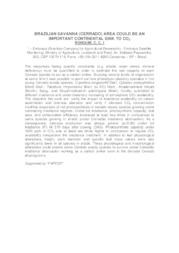Brazilian savanna (cerrado) area could be an important continental sink to CO2.
Brazilian savanna (cerrado) area could be an important continental sink to CO2.
Author(s): RONQUIM, C. C.
Summary: The responses facing specific constraints (e.g. shade, water stress, mineral deficiency) must be quantified in order to estimate the real capacity of each Cerrado species to act as a carbon sinker. Studying several levels of organization at same time it was possible to point out how phenotypic plasticity operates in five young Cerrado woody species, Copaifera langsdorffii Desf, Cybistax antisyphilitica (Mart) Mart., Tabebuia chrysotricha (Mart. ex DC) Mart., Anadenanthera falcata (Benth.) Speg., and Stryphnodendron adstringens (Mart.) Coville, submitted to different irradiance and under transitory increasing of atmosphere CO2 availability. The objective this work are verify the impact of irradiance availability on carbon assimilation and biomass alocation and verify if elevated CO2 concentration modifies responses of net photosynthesis of cerrado woody species growing under contrasting irradiance regimes. Under full irradiance, photosynthetic capacity, leaf area, and carboxilation efficiency increased at least two times in comparison to same species growing in shade (under Cerradão irradiance attenuation). As a consequence, biomass production was always greater (p<0.05) under full irradiance (FI) till 570 days after sowing (DAS). Photosynthetic capacity under 1600 ppm of CO2 was at least two times higher in comparison to regular CO2 availability irrespective the irradiance treatment. In addition to leaf physiological alterations, height, stem diameter and specific leaf mass values were also significantly lower in all species in shade. These physiological and morphological alterations could enable some Cerrado woody species to survive under Cerradão irradiance attenuation working as a carbon sinker even in the densest Cerrado physiognomy.
Publication year: 2011
Types of publication: Abstract in annals or event proceedings
Unit: Embrapa Territorial
Keywords: Biomass partitioning, Irradiance, Leaf gas exchange
Observation
Some of Embrapa's publications are published as ePub files. To read them, use or download one of the following free software options to your computer or mobile device. Android: Google Play Books; IOS: iBooks; Windows and Linux: Calibre.
Access other publications
Access the Agricultural Research Database (BDPA) to consult Embrapa's full library collection and records.
Visit Embrapa Bookstore to purchase books and other publications sold by Embrapa.

